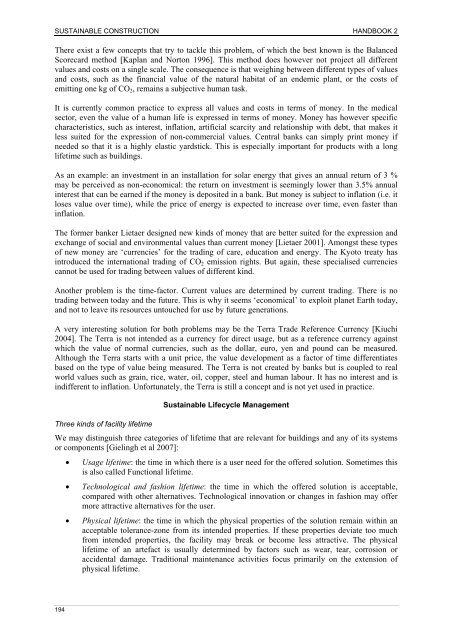Industrialised, Integrated, Intelligent sustainable Construction - I3con
Industrialised, Integrated, Intelligent sustainable Construction - I3con
Industrialised, Integrated, Intelligent sustainable Construction - I3con
Create successful ePaper yourself
Turn your PDF publications into a flip-book with our unique Google optimized e-Paper software.
SUSTAINABLE CONSTRUCTION HANDBOOK 2<br />
There exist a few concepts that try to tackle this problem, of which the best known is the Balanced<br />
Scorecard method [Kaplan and Norton 1996]. This method does however not project all different<br />
values and costs on a single scale. The consequence is that weighing between different types of values<br />
and costs, such as the financial value of the natural habitat of an endemic plant, or the costs of<br />
emitting one kg of CO2, remains a subjective human task.<br />
It is currently common practice to express all values and costs in terms of money. In the medical<br />
sector, even the value of a human life is expressed in terms of money. Money has however specific<br />
characteristics, such as interest, inflation, artificial scarcity and relationship with debt, that makes it<br />
less suited for the expression of non-commercial values. Central banks can simply print money if<br />
needed so that it is a highly elastic yardstick. This is especially important for products with a long<br />
lifetime such as buildings.<br />
As an example: an investment in an installation for solar energy that gives an annual return of 3 %<br />
may be perceived as non-economical: the return on investment is seemingly lower than 3.5% annual<br />
interest that can be earned if the money is deposited in a bank. But money is subject to inflation (i.e. it<br />
loses value over time), while the price of energy is expected to increase over time, even faster than<br />
inflation.<br />
The former banker Lietaer designed new kinds of money that are better suited for the expression and<br />
exchange of social and environmental values than current money [Lietaer 2001]. Amongst these types<br />
of new money are ‘currencies’ for the trading of care, education and energy. The Kyoto treaty has<br />
introduced the international trading of CO2 emission rights. But again, these specialised currencies<br />
cannot be used for trading between values of different kind.<br />
Another problem is the time-factor. Current values are determined by current trading. There is no<br />
trading between today and the future. This is why it seems ‘economical’ to exploit planet Earth today,<br />
and not to leave its resources untouched for use by future generations.<br />
A very interesting solution for both problems may be the Terra Trade Reference Currency [Kiuchi<br />
2004]. The Terra is not intended as a currency for direct usage, but as a reference currency against<br />
which the value of normal currencies, such as the dollar, euro, yen and pound can be measured.<br />
Although the Terra starts with a unit price, the value development as a factor of time differentiates<br />
based on the type of value being measured. The Terra is not created by banks but is coupled to real<br />
world values such as grain, rice, water, oil, copper, steel and human labour. It has no interest and is<br />
indifferent to inflation. Unfortunately, the Terra is still a concept and is not yet used in practice.<br />
194<br />
Sustainable Lifecycle Management<br />
Three kinds of facility lifetime<br />
We may distinguish three categories of lifetime that are relevant for buildings and any of its systems<br />
or components [Gielingh et al 2007]:<br />
• Usage lifetime: the time in which there is a user need for the offered solution. Sometimes this<br />
is also called Functional lifetime.<br />
• Technological and fashion lifetime: the time in which the offered solution is acceptable,<br />
compared with other alternatives. Technological innovation or changes in fashion may offer<br />
more attractive alternatives for the user.<br />
• Physical lifetime: the time in which the physical properties of the solution remain within an<br />
acceptable tolerance-zone from its intended properties. If these properties deviate too much<br />
from intended properties, the facility may break or become less attractive. The physical<br />
lifetime of an artefact is usually determined by factors such as wear, tear, corrosion or<br />
accidental damage. Traditional maintenance activities focus primarily on the extension of<br />
physical lifetime.






